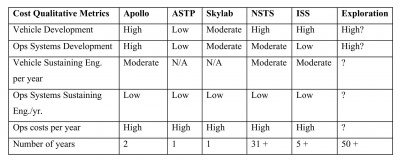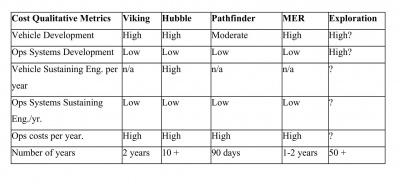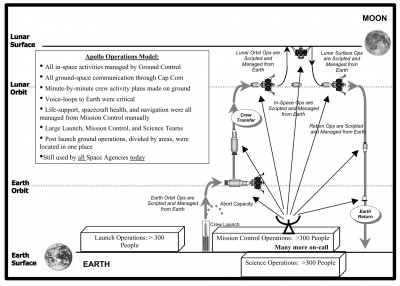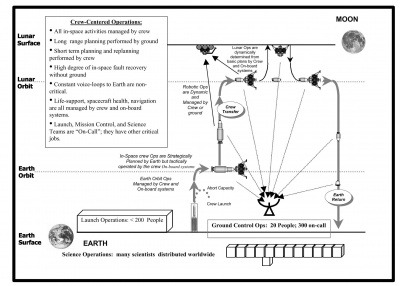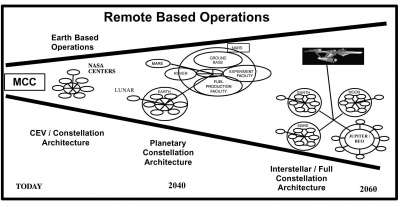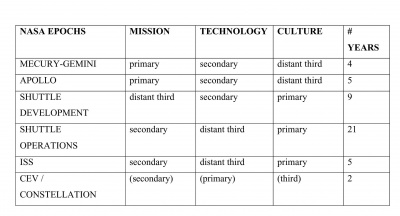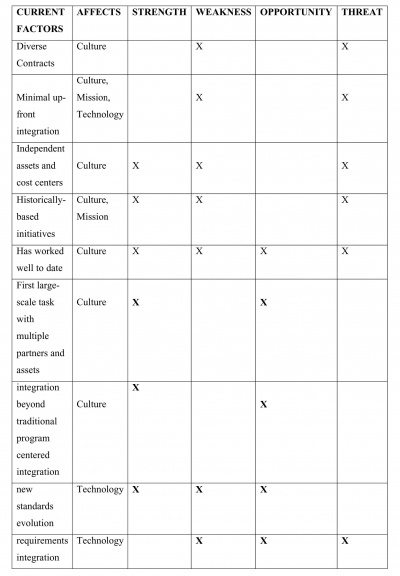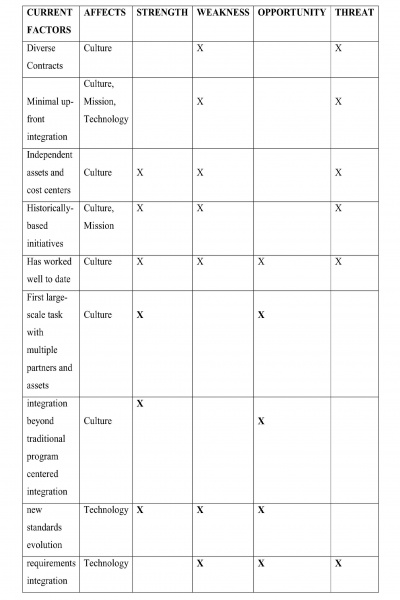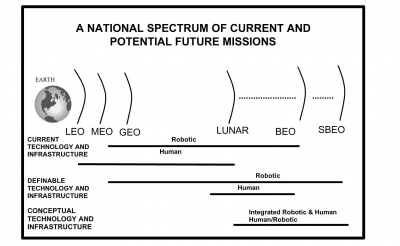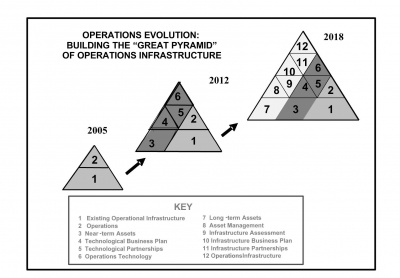Beyond Earth (ATWG) - Chapter 25 - Efficient, Affordable Explorations Operations: Crew Centered Control via Operations Infrastructure by T.E. Diegelman, R.E. Eckelkamp and D.J. Korsmeyer
From The Space Library
Chapter 25
Efficient, Affordable Explorations Operations: Crew Centered Control via Operations Infrastructure
By Thomas E. Diegelman, Richard E. Eckelkamp and David J. Korsmeyer
A significant challenge facing NASA's new explorations initiative to the moon and beyond (1) is to design a program of science and engineering exploration objectives that are both meaningful and affordable. This challenge is significantly different from that of the 1960's Apollo program wherein the object was to land an American person on the moon first and within nine years.
Apollo was accomplished with excellence. Talented teams throughout America set out to achieve an unparalleled technical marvel and to establish our country as a leader in spaceflight. Many new innovations in program management, space operations, and space hardware and software were developed methodically in the presence of enthusiasm and national competition. We Americans impressed ourselves and the rest of the world with our accomplishments.
However, low program costs were not primary drivers in these pursuits. Focus was placed on the end objective, winning the race to the moon. Some considerations were given on how to use or adapt the Apollo hardware on future space missions. Such thought helped produce the subsequent Skylab missions as well as helped develop concepts for follow-on activities on the moon, later called Apollo Applications, and for planned traverses to Mars.
Post Apollo, these relegated-to-secondary place drivers began to have unanticipated affects. In the heat of accomplishing the marvelous Apollo feats NASA had produced a large skilled work force and an extensive infrastructure. A logical follow-on activity for NASA as it would have pursued its next challenging project would have been to transform the workforce and infrastructure into forms and sizes that could be sustained. It was anticipated by NASA at the time that the next space project would be quick in coming and would be a natural extension of Apollo efforts leading to ever greater progress in the field of space exploration. Not yet conceived was the idea that the space efforts could become self-energizing through emerging economic benefits to commercial space enterprises.
But that anticipated quick next challenge did not occur. The American people, partially pushed by the news media, moved to other concerns - significant environmental issues and the quagmire of Vietnam. Missing from the American prospective were realizations of the importance and long-term significance of making additional progress on the space frontier, the importance of the strategic and eminent economic benefits of space work, and of the importance of setting and accomplishing worthwhile goals as a society. After having initial successes with the Apollo Soyuz Test Program and Skylab, the first U.S. space station, NASA struggled to outline a space future. In fact, NASA did not even offer a convincing case for a space future.
NASA, instead, found itself in organizational survival mode, concentrating its efforts on planning and selling some new space program that Congress and the American people would support, an so the Space Shuttle Program was born. Money available for space was scarce, however. Due to ensuing yearly budget cycle pressures and schedule pressures NASA concentrated on vehicle hardware and software development, leaving to the unspecified future any concentration on providing an efficient operational system and associated infrastructure that would lower total lifetime costs.
The results have been quite costly and disappointing. As a result of high operations costs (see Tables 25.1 and 25.2). (2) NASA has cancelled or not sponsored many worthwhile and well-defined science and explorations programs. It should be emphasized that these consequences have not sprung from, lack of public support, lack of planning, or ignorance. Rather, they have come as a result of building subsequent programs upon the Apollo infrastructure and techniques, none of which were designed to conduct long-term operations. The resulting cost in operational dollars and human capital of both the shuttle and the space station programs has been and is enormous.
Table 25.1 U.S.A Manned Space Program Relative Costs
Table 25.2 U.S.A. Robotic Space Program Relative Costs
NASA has not been alone in falling into this negative capital pit thought process. All the other space agencies: of Russia, of Europe, and now it appears, of Asia have suffered or will face these same high costs and accompanying limited results. It, therefore, is essential that a sustainable exploration program should allocate funds from the onset to develop an efficient operational exploration system. Mars and beyond exploration requires new techniques and organizational methods due to the sheer distances involved. In addition, both program and economic risks must be reduced by accomplishing early technical, much like Mercury, Gemini, and Earth orbit Apollo missions were use as stepping stones to the lunar landings. Accompanying these technical milestones were a series of infrastructural and managerial developments that enabled Apollo to succeed. We must do this again for the exploration era.
Change within NASA today is not only necessary, but mandatory. To have a successful and flourishing exploration program, we must make an "Earth-shaking change" in how we perform command and control. What is needed is to build a new robust human and robotic exploration operations command and control architecture and associated evolving infrastructure, one such version we name "Crew-Centered Control". The word "new" could sound frightening to some who might imagine huge expenditures. But how many of us, for example, still use old energy-inefficient machinery or computers when modern versions exist that are far superior in performance and are cost effective to boot? In the instance of ground control of space operations, the inefficiency lies in the large number of people required to perform tasks that now can be automated, in the toll on human health of controllers doing repetitious tasks manually, and in the accompanying historically-rooted management infrastructure.
Keeping in mind that, "They who begin a program with a large marching army continue that program with a large marching army," we propose to move from the current ground-centered control to this crew-centered control method (see Figures 25.1 and 25.2) (2), (3), (4). (We will discuss how this might be accomplished later in this chapter.) Using this method missions are designed to be as self-sufficient as practical. Operational control is pushed into the field, whether that control be in free space or on planetary surfaces. Distributed ground support teams and centers are used on a non-continual basis to augment what are essentially crew-controlled and crew-led operations.
Figure 25.1 shows a mission operation model that relies on nearly flawless communication, adequate reliability of a minimalist vehicle, and a relatively and a large staff of technical talent on the ground, serving as a human-powered archive of the necessary and sufficient information and knowledge to execute the mission. In 1969, when the first lunar landing took place, it was not possible to deploy additional technology, because we were employing all the technology that we had. Automation was minimal. The mission, to get to the moon before the Russians, was done using the only system available and capable to do so - the world's first and still best computer, man.
Figure 25.1 Apollo Style Mission Scenario
Considering the fact that the Apollo missions were relatively short duration (about a week), the Apollo model for organizing the mission was not only quick and effective in the short term, but was probably close to being the most cost effective model, since the infrastructure consisted only of hardware systems and the personnel. Little thought, time or process development other than the minimum needed to rush this to success were invested.
For subsequent programs, continuing to perform tasks manually began to take its toll in human capital, as may be seen in the "stress cracks" that appeared in the Skylab flight controllers and the Skylab crews. More recently, the experience of flight controller "burn-out" has been a very noticeable aspect of the International Space Station Program.
The operational scenario shown in Figure 25.2 reflects the relatively large number of personnel that will probably still be required for the early exploration activities - the Crew Excursion Vehicle (CEV), Constellation, and other launch vehicles. Fewer people are involved than for shuttle and station support, and likely could be reduced further as the systems gain maturity. But the striking change is that the crew is now the epicenter of the information, knowledge and first-line direction of the flight, while ground personnel take on more the roles as offline system experts, longer-term planners, risk assessors, and data brokers.
Further, the traditional location of science and systems experts at a single control center, such as the JSC Mission Control Center for manned missions, gives way to experts residing at various geographic locations that are linked together electronically. Today's communication technology of "e-access" can enable collaborative productive environments that are geographically, culturally, and organizationally diverse. This is quite impressive. A significant challenge is to devise human interactive processes that enhance versus slow down information flow. The slowing of information flow is technically risky and, in the past, has been blamed for accidents. As Alvin Toffler put it, "Money moves at the speed of light. Information has to move faster." (9)
Figure 25.2 The Operational Goal: Onboard Crew Centric Operations
Duty Assignments
What are the "duties as assigned" in this new operational scenario? In the crew-centered concept, the exploration crew will, as a minimum, be required to execute the following functions:
1) be the center of communications, command and control activities,
2) travel in vehicles with autonomous navigation, guidance and control and automatic system health monitoring,
3) perform all weekly task planning and daily scheduling,
4) deploy scientific and engineering equipment as scheduled,
5) perform scientific, exploration, and engineering activities in free space and on planetary surfaces,
6) control or manage resident robots in pursuit of the above activities,
7) manage in-space and planetary surface facilities,
8) perform the majority of system error recoveries using in situ capabilities,
9) manage in-space and planetary surface facilities, and
10) perform the majority of system error recoveries using in situ capabilities.
Similarly, there is a refocused set of tasks for ground personnel. The new tasks will require the execution of at least these defined tasks:
1) perform strategic and tactical monthly and yearly planning,
2) perform permission contingency analyses and produce associated execution products,
3) conduct permission crew training on the ground,
4) perform interplanetary and trans-lunar trajectory design,
5) provide launch vehicle checkout and preparation support,
6) provide traffic control for launching and landing vehicles, much analogous to the FAA for aircraft,
7) provide on-call onboard and field system expertise,
8) perform long term trending and correlation,
9) provide on-call failure analyses and trouble-shooting,
10) perform needed lengthy reconfiguration procedures development,
11) develop robotic execution scripts,
12) provide remote telerobotic robotic control when practical and cost-effective,
13) develop crew training and instructional programs and associated uplink material,
14) manage and control ground data facilities, and
15) use feedback to improve the efficacy of operational process and programs.
Measures of the success of the crew-centered operational control will include the following tactical measurements:
1) high number of exploration objectives met,
2) low cost per accomplished exploration objective,
3) high number of crew tasks and robotic tasks performed in a work day,
4) efficient rate of resource use,
5) low number of planning personnel,
6) low number of ground control personnel required,
7) low number of uplink commands from Earth,
8) high number of parallel activities accomplished per unit time,
9) short time required to train crew and robots,
10) routine ability to field new equipment and experiments without requiring crew training on Earth,
11) routine ability to manage multiple tasks at the same time,
12) crew has situational and contextual understanding of activities being performed,
13) high safety of crew maintained during EVA / IVA,
14) short time to diagnose common problems and modify plans accordingly,
15) short systems down time due to problems or maintenance,
16) low amount of logistics required to maintain operations (reuse and recycling decrease the amount of resource planning on the ground.),
17) low amount of Earth human intervention time required,
18) number of replacements versus repairs required,
19) high amount of information and context recorded for every exploration activity, and
20) short time needed to understand what occurred in the activities by third parties5 .
To accomplish the process of vectoring toward more efficient operational control structure requires:
1) substantial advances in some areas of autonomous systems and robotic control,
2) development of multi-sensor field exploration robots, human assistant robots, and other construction robots,
3) robust space-qualified computers and advanced operational software,
4) first-time development of methods to perform crew-centered control and integrated robot-human operations,
5) distributed interconnected ground support teams and control centers, located at natural centers of talent base, used to provide crew support services that are infeasible to locate in the exploration field (the exception rather than the rule),
6) a robust web-like Earth-moon-planetary communications evolvable infrastructure, and
7) rapid crew access to large multi-medial databases for both exploration, maintenance, and repair tasks 4,5
Shifting to the New Model
These changes can theoretically be accomplished in stages as the exploration program develops at a moderate rate, first with the moon and then beyond. A reduced manage approach is to begin is now, as shuttle operations wind down. The development of exploration command and control for lunar exploration could go as follows:
1) Earth-based control of multiple reconnaissance robots
2) Earth-based control of teams of infrastructure-building robots
3) Astronauts arrive and work in cooperation with and exercising shared control of robots.
a. building infrastructure -robotic assembly
b. exploring in the lunar environment
c. Astronaut mission duration measured in months and years,
4) The lunar surface base comes on-line with near autonomous operations and daily-weekly planning capabilities.
5) Remote site sorties begin, supported by a substantially capable surface base (2), (5), (6)
A logical time line for the evolution of the operations infrastructure development to support this crew-centered command and control for lunar exploration and beyond could be proposed as follows:
1) 2006 First draft of operations processes and NASA centers' tasks functional allocation trades
2) 2007 Operations processes and functional allocation trades finalized
3) 2008 Initial Centers online for vehicle & robotic control
4) 2009 NASA distributed command and control operational plan in place
5) 2011 NASA Inter-control center systems fully operational
6) 2011-2015 International command and control plan development
7) 2019-2025 Multi-national control centers online
8) 2018-2023 International Martian command and control plan development
Figure 25.3 The Long Term Future of Crew centric Operations
Given this proposed timeline, a summary extrapolation for the near term future can be produced (see Figure 25.3). Although the future may not unfold as depicted, the extrapolation presents a vision that can be used to determine required technological end products. A good reference of how end-space systems can be described using contemporary technologies , yet emerge 40-50 years later using unthought-of technologies may be seen in a short story by Arthur C. Clark called Islands in the Sky. 16 In this story, the illustrations tell a complete story in of themselves. Everything from the crew station, the assembly process, tools, to the EVA gear and suits is described and depicted as the 1950's technology would allow these concepts to be defined. (One might wonder and speculate about how the personal data assistant and cell phone would have been drawn in those yesteryears.) However, the story is more than a metaphor to be updated to 2005 terminology. The story speaks of emerging challenges for the next generations of space faring nations to hone, to sharpen, to crystallize this vision, and most importantly, to build this vision!
How Is NASA to Achieve Operational Change?
Near-radical change or "reinvention" is needed. 8 Crew-centered control is a very worthwhile and necessary operational configuration to establish.. The crucial question is, "How can NASA go from the current operational status quo to an exploration era of conducting efficient operations?" "Operations" will take an expanded meaning and will be defined later. One cannot look backward into space history. The past has little ability to pursue better strategic methods because then "good enough" and "available now" were the order of the day during Apollo. In addition, past successes, even if applicable such as Apollo, shuttle, and the ISS, do not presage future success (Warren Bennis, Organizing for Success (10)). Well-thought out planning on multiple levels is essential for future success. The generation of plans as products should always be considered on equal footing with other programmatic decisions and endeavors. A willingness by the entire organization to make necessary changes is a required condition for success. There can be no pockets of retro-thinking. Why? Because, as Bennis puts it, "None of us is as smart as all of us." (10)
To understand the how of change, consider this analogy. If one wants, to change a house substantially, based on new needs, one could:
1) demolish the old house and start anew with fresh materials (clean sheet approach),
2) build additions to the house and move, as needed, walls and facilities to achieve the desired changes (incremental change),
3) disassemble the old house and use the existing components plus new needed parts to achieve the results,(full renovation),or
4) use existing structure as is, but reallocate functional space and resources to accommodate the desired changes (reallocation of function).
In these proposed approaches, the richer options, are in descending order. These methods apply equally well to a company or organization that needs change. In the case of NASA, due to the skill of its workforce and its past history of success, the demolition case should be the last choice. In the house analogy, demolition is viable only if one doesn't mind living outdoors while the replacement house is being constructed - a significant issue in cold climates. Any of the other three solutions can work. There is definable wisdom in choosing to use existing resources. The existence of the current NASA organizational infrastructure inertia that has produced the current high life cycle mission costs would tend to move the solution away from method two and towards either method three or four, with some preference for three.
The inescapable fact is that if NASA does not make substantial organizational and process changes, neither crew-centered control or overall exploration success by NASA will occur. So, which change method should be used to accomplish a crew-centered operations approach? In the spirit of acknowledging that always the devil is in the details, an answer, will be stated in terms of a "wire frame" or outline / checklist. This serves to guide change, based upon a model of the organizational performance as a definable and measurable system. The key, then, is system performance enhancement in the context of system change. The following equation is proposed here as the hypothesis for this model:
Event happening = Necessary elements + Sufficiency condition
Proper technology development is the necessary condition for on-board operations to be instituted. This technology development alone will not suffice for efficient operations to occur. The technology must also be deployed. Whether technology is deployed or not and how this done, are organizationally driven. The sufficiency condition is, then, is that the organization must be adeptly tuned into the technical environment, the program challenges, and most significantly, be aware that the critical factor is the organization itself - its strength and its purity of intention to accomplish its mission. The resources needed and time required are mandatory, and they will appear almost magically in the presence of organizations committed to the task. Therefore, using the hypothesis given above, the particular equation for success of implementing a crew-centered exploration operations system, methodology, and associated infrastructure is:
Crew-centric Operations System Establishment (COSE) = Enabling Technology Development + NASA Commitment to Change + Development Risk Acceptance + Appropriate Organizational Restructures
The center of mass of NASA's effort necessary to accomplish Crew-centric Operations System Establishment (COSE) lies in the organizational and process side of the house rather than on the technological development side . As difficult as this effort might sound, it indeed is not. There are simplistic tools available that work and work well. One tool found helpful by companies seeking to "reinvent themselves" is the use of the SWOT analysis approach: (15)
- Strengths - what does the company do well, better than the competition?
- Weaknesses - what does the company not do as well as needed to succeed?
- Opportunities - what changes in management process and structure would allow what has not been previously possible to become possible?
- Threats - what are the threats to the company and to the industry associated with making these changes? Let's employ this SWOT analysis in three principle areas of attribution: mission, technology and culture. These broad, rather simplistic areas allow a set of metrics and goals with definitive steps to be defined that assure that NASA can accomplish its objectives in the contemporary political, international and economic environments.
Mission is the metric attribute of an organization that defines the "why" of the business. The goals and the business objectives are uniquely described by the mission. The NASA mission in the Apollo era was being on the moon first, accepting the associated risks, and accounting for costs and repercussions in areas such as work force, sustainability of mission, and infrastructure This singular focus brought great success, yet produced long-term institutional processes and structures that eventually caused unintended results mentioned in the first part of this chapter.
Technology is the metric attribute of whether or not an organization is mature, stable, cutting edge, leading edge, or bleeding edge in its employment and use of technology. If technology is of central importance, then the company will do what is must do in the technology arena in order to execute its business plan successfully. If on the other hand, technology is not at the epicenter of the company and its motivations, the company will do only what is comfortable regarding the technology. For example, in the Apollo program, NASA pioneered the use of digital computers using cutting edge Diode Transistor Logic, but for the shuttle program, however, comfortably chose to employ the AP-101, a computer historically (and currently) used in the B-52 program.
Culture is a metric denotes of how the organization sees itself as being and how it sees itself as operating in the marketplace and / or in its work environment. The culture metric reflects the organization's response to internal mission and technological stimuli, as well as to external stimuli. As with technology, culture can be an epicenter measure or a meaningless curiosity. Words like "insular", "open", "learning", and "hide bound" are often used to describe culture.
Culture is defined by the folkways, mores', and traditions as well as, more importantly, the belief systems. Belief systems, although sometimes labeled a "soft science" in human factors, cannot be ignored. As Henry Ford put it succinctly, "Whether you believe you can or you can't, you are generally right."
The reason for the introduction of these three measures of an organization and its performance is simply to measure the organization. These measurements do not replace traditional performance and product measures, but rather, add to them. In a sense, this metric prescribes and even predicts performance because it serves to measure whether the organization is "configured for success". There is no one-size-fits-all set of business metrics.
Intelligence and insight are required to establish the specifics of these metrics, conduct the measurements, and, know what is valid within the data. Meaningfully information extraction from mounds of data is anything but a science. It is an art form. And it is an art form of the highest order in situations where people and human nature are part of the equation. This is NASA's turf - highly intelligent people challenging the laws of nature and expecting to beat the odds and win often.
Table 25.3 presents a summary of NASA's importance rating for mission, technology, and culture during past and present programmatic epochs, as well as a surmise of how our nation, aware of its technology base improvements needs, would rate the factors for the exploration era.
Table 25.3 Primary indicators of the Focus of NASA during Program Epochs
The culture rating switched from last place to first during the more recent NASA programs. This switch is unfortunate, and unfortunately it was no accident. Companies take wrong turns and have to be "righted". This is true during all stages of a program, even when resources are not an issue. In the early Apollo days, George Mueller "wreaked havoc at NASA headquarters" putting the proper emphasis of the organization on the mandatory issues.
(17) This "shaking up" of the in-place management practices is quite necessary in organizing for success.
In the exploration era, it is anticipated that culture will return to last place as in Apollo. In addition, it is quite possible that careful strategic thought at the government's executive level will elevate the exploration era technology factor to primary focus as an integral part of a national program to promote excellence in technology, innovation, and education. Certainly the emphasis in Apollo placed on "systems management capability" by Gen. Sam Phillips will be just as critical in Constellation as it was in Apollo. Even with this emphasis, the Apollo cost / schedule slippage factors for the F-1 engine, the science applications, and the human space craft elements to ranged from 1.6 to 4.75 - figures absolutely not acceptable in the environment we find in 2005. (17) So we must do better!
To get to a new place, one must know from where one starts. One set of observations about NASA's past programs using the SWOT analysis is found in Table 25.4. Each "X" symbolizes that one or more activity components have been judged to have the significant programmatic impact. The table shows only one of several possible categorizations. A similar set of additional factors, see Table 25.5, could be predicted for the exploration era based on forethought and examination of historical NASA corporate information. Components such as multi-discipline integration, universal standards consolidation, increased use of automation, full-up multi-national operations, and full requirements integration would probably be in the table. For a more complete discussion, see reference (15).
Table 25.4 NASA Current Programmatic Component Categorizations
Table 25.5 Possible Additional NASA Exploration Programmatic Component Categorizations
Table 25.5 is introduced here to provide an illustrative example of how programmatic factors might relate to the organizational attributes and organizational analysis factors. This SWOT analysis needs to redone periodically due to changing issues, resultant impacts, and hence, the need to replan.
The space mission profile also affects the factors and impacts, since the technology requirements are drawn in. In an abstract way, Figure 25.4 shows the broad categories of the NASA missions past, present and future. The technology aspect is easily seen. For example, some mission scenarios—especially the human missions beyond low Earth orbit (LEO)—demand safety considerations that will require investment in technology. Against this process, Tables 25.4 and 25.5 are proposed as a first cut at a set of issues, with the understanding that the farther out the mission and time line, the less the specificity of the factors, and the more change is to be expected as the far future missions evolve, based upon successes and failures of the current missions, environment, and the rest of the factors that were introduced into the mission / technology / culture metric set.
Figure 25.4 - NASA Mission Profile - Technology and Challenges (key: L-low, E-Earth, O-orbit, M-middle, G-geosynchronous, B-beyond, S-significantly)
Once an organization is "engaged", that is, it accepts the realization that the organization itself, the environment, and the rest of the attributes all play together in the presence or absence of a plan to produce results, the sufficiency condition in the equation is supplied. The equation becomes an equality mathematically. In terms of organizational dynamics, this sufficiency means that there is an effort that is recognized to be more important than any other activity - called planning, that is, working the analyses, the issues, the challenges, the interfaces, the techniques, and the infrastructure required to accomplish the desired mission.
These engaged activities are rolled into a forward plan that is atypical of "non-engaged" organizations. Such an atypical plan is necessary to get to crew-centric operations. At first glance, the challenges to transforming the current space operations into crew-centric operations might appear to be technical. In fact the real challenges lie in the non-technical human and managerial areas, a fact that the "engaged" plan, must take into account with concrete steps to accomplish change in the mission and cultural metrics in the midst of an evolving exploration environment.
The ideas above might sound sweeping and too general to be meaningful. Let the skeptical the reader take the challenge to trace the near demise of the General Motors Corporation, that went from a corporation with the reputation of being such an economic powerhouse that, "as General Motors goes, so goes the nation" , to being an anemic corporate shell with a junk bond rating. Its market share is less than one third of what it was even 25 years ago. At a summary level, what are the issues that changed GM's situation to such a bad dream? Perhaps, it was the belief that GM was too big to be taken down, that GM was synonymous with a "job for life", where life was defined as "30 years and out with a gratuitous pension", an assumption that the forty percent plus of the market share was "theirs" to keep, that foreign competition with its low-cost, low profit vehicles could be dismissed as meaningless non-threatening competition, and perhaps lastly, that poor quality products could be foisted upon the buying public without consequences because there were no equivalent ,alternative sources of vehicles.
Could we apply some of these warnings to conventional space agencies and aerospace companies? In the constant market environment of the 1950's, GM's corporate missteps could perhaps be non-fatal, but not in the global economy of the 1980's and beyond. Corporate illness and demise can and does happen to the invincible. This is also true in space endeavors.
An Analytic Forward Plan: Getting to an Efficient Operations Infrastructure
One pathway towards efficient operations being considered by elements within NASA 7,12 is shown in Figure 25.5. This figure models the progression of thought from concept of current operations enhancements to effective decision processes that will achieve more-efficient operations through block building and iteration converting insights self assessment into integrated action plans. This is what Peter Senge called the "Learning Organization", one that uses the performance measures of its functions in a recursive closed loop set of learning experiences thus insuring the vibrancy of the corporate entity which, thus assuring the ability of the organization to produce successful products. (8)
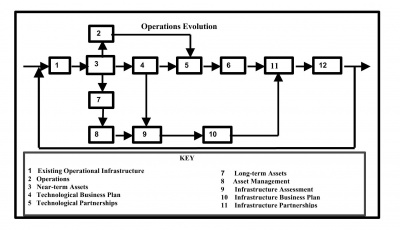 Figure 25.5 Feedback Relationship Between the Elements of the Operational Organization Evolution
Figure 25.5 Feedback Relationship Between the Elements of the Operational Organization Evolution
Any system can and should be viewed and treated as developmental through out its entire life cycle. Definitions of the elements of Figure 25.5 are stated here in generic terms and are applicable to any sufficiently large organization involved in manufacturing, finance, commerce, and operations industries. Definitions tailored to the operations area are:
1) Existing Operational Infrastructure is the totality of the integrated systems, processes, and "hard goods" that comprise the environment necessary to execute the mission, programs, objectives and infrastructure maintenance that the organization pursues. This definition can change if the funding, life cycle definition, or programmatic direction changes, thus sometimes causing obsolescence. The concept remains, however. It is what it is at any instant in time.
2) Operations is the global task of performing activities to achieve the defined missions within the bounds of the infrastructure constraints. For NASA, the function, as defined here, does not include research on operations, although in general it should be.
3) Near-term Assets are additional, readily available systems, tools, and processes that could be inserted into the existing operational infrastructure as needed. These assets are identified separately because their adoption could enhance and add to the base of operational infrastructure.
4) Technology Business Plan is the high level plan, independent to some degree of the particular programs, wherein the decisions on whether to develop or implement particular enabling technologies are made. Enabling technologies are selected based on their estimated value to improve mission success and operational efficiency. The plan specifies how the selected promising technologies fit within the budget and how they are to be integrated into the mainstream operational system flow. Care is taken to honor adherence to core company operating principles, goals and established partnerships. Elements of this business plan support Infrastructure Assessment.
5) Technological Partnerships are the agreements required to implement the Technology Business Plan. These partnerships will effect the Technology Business Plan in a closed- loop fashion, will help define the totality of the Near Term Assets, and may even influence Long Term Asset Management and Infrastructure Business Plans.
6) Operations Technology is the super set of technologies that provides the Operations segment with adequate "building blocks" to change existing operations in a strategic manner, utilizing both evolving technologies and existing technologies, into an ever-improving set of efficient mission operations. These employed technologies feed mission-derived information back into the planning, partnerships and long range planning processes. Once this function is fully matured, the once pinnacle of the organization operations - becomes a building block for the Operations technology function, that in turn, becomes the main support structure for the Operations Infrastructure - the ultimate re-engineering target. (See Figures 25.6).
7) Long-term Assets are future systems, assets, tools, and processes that can be conceptualized, prototyped, and eventually inserted into the near-term asset systems. Ultimately, these assets cycle into the area defined as infrastructure. These assets can eventually imbue the operational infrastructure with synergistic efficiency. Note, as these definitions are unfolded, there is inherent recursion back on other definitional blocks.
8) Asset Management is the cost-effective stewardship of the capabilities both on-line and being brought online in the near term. This activity assumes the generation of and use of metrics that both support the Infrastructure Assessment function and measure the efficacy or mission performance using basic performance feedback data.
9) Infrastructure Assessment is the evaluation of overall organizational and mission performance based upon analysis of the Asset Management and Technology Business Plans. Metrics, such as the detailed SWOT analysis shown in this chapter, are used to judge the effectiveness of elements at all of the company management and mission operations infrastructures.
10) Infrastructure Business Plan is the plan that results from the integration of the partnerships, the assets, the technology plan and the current practices. This is the unifying document that defines the plan that pushes the organization to the pinnacle of Operations Infrastructure by leveraging off the Operations Technology and Infrastructure Assessment. Contained herein are the keep / cut / make / buy sort of decisions that clearly follow the incremental "lessons learned" approach.
11) Infrastructure Partnerships are the relationships that are required to acquire, maintain and operate the strategically-defined architecture and assets. These relationships differ from the technology partnerships in that the technology aspect is not the only consideration. This set of relationships is assembled to enable the long-term support of a very sophisticated, highly-integrated set of assets that ,based on broad and effective feedback, is strategically positioned to reduce cost and be sufficient robustness to continue product production or operations while accommodating internal changes and external stimuli.
12) Operations Infrastructure is the totality of the operations, assets, planning and most importantly, the responsive connection to the client community. This includes the definitions of the critical technologies, skills, external stimuli, cultural, finances, mission goals, and performance metrics that provide sufficient feedback to the eleven support functions, eventually enabling the shrinking the large pyramid back to a pinnacle that stops with Operations Technology or even Operations.
Not apparent in Figure 25.5 or in the definitions is the relationship among the building blocks. If we take the feedback diagram convention to be the "IN" arrows meaning "supported by", and the "OUT" arrow meaning "supports", the blocks may be rearranged to show the relationship that exists between the process steps. The stacking is shown in Figure 25.6, and is referred to, tongue-in-cheek,, as "building the Great Pyramid", referring to the ultimate goal of establishing the Operational Infrastructure as the highest level of integration of the organization's plan, products, and knowledge. It should be noted that a rigid, inflexible, non-learning organization will not be able to complete this reinvigoration process and will fall short at a lower level than the (12) defined block triangle, pinnacled at Operations Infrastructure.
Figure 25.6: Building the Operational Infrastructure
An example would be helpful to observe the process. Referring to the partial list of potential challenges and opportunities in the area of communications, (12) we see what at first glance looks to be a technology question. There are, however, mission and culture factors sprinkled in as well which, as we have pointed out in Apollo history, are critical to success. The objective of our example exercise is to identify the necessary elements (the Issues) and the sufficiency conditions (the Affects) so that an analysis of the risks can be stated in a uniform, addressable fashion. Using SWOT analysis, the current environment (triangle elements 1-2) is reviewed and the plans for triangle elements 3-6 are formulated. At this point, NASA would have a forward plan to keep the communication system for Constellation viable for at least the duration of the program. At this point the trade studies and data gathering would barely have begun, so there is no final answer yet. However, there would have been back-of-theenvelope concepts defined that would merge assets of the Deep Space Network, NASA's current NASA Integrated Services Network, and commercial technologies.
The final steps in the process are to evaluate these options and select a strategy that could potentially allow the designed Constellation era communication system to serve as the backbone of the communications link for all of NASA as well as for the non-NASA voice, video, and data connectivity, much like the world-wide Internet web does today. These are steps 7-11, which result in a communication system that supports lunar missions, remote lunar operations, robotics, science and commercial interests. The system would then be expanded and built-out to cover communications to Mars and other destinations, hopefully without fundamental changes, (since strategic planning of the capabilities was done when the focus was lunar missions). This is block 12, Operations infrastructure.
Expensive as this analysis process might seem and indeed might be, the alternatives are less attractive. If the lunar communications system had to be modified for Mars missions to the same extent that the shuttle system had to be modified for station, the cost would be prohibitive. In addition, the risk associated with the lack of run-time experience with the product would almost insure inadequate risk abatement.
Once the twelve element plan for energizing an industry's infrastructure, the "Great Pyramid", is built, there is still no absolute guarantee of success. However, there is the guarantee that if the process is followed on a technical mission, a success path can be identified. What then is the "Great Pyramid"? It is a "System of Systems" icon for any industry seeking success to follow. In our focus here, it is NASA using the model to lead the team of nations, contractors, and entrepreneurs all of whom are seeking the safest, most reliable, most cost-effective access possible to all levels of space, from LEO to BEO. This is NASA's "value chain", as Porter refers to it in his book. 11 That System of Systems has the type of connectivity to the American people that will clearly show the benefits of space endeavor. These benefits will serve NASA well as an instrument to accomplish successfully the critically important need outlined in the President's vision in January 2004, "engaging the American people".
The Best Could Be Yet to Come - A Hope with Warning
With first class planning and unwavering commitment to building and maintaining the "learning organization", the application of these iterative steps can bring about a successful American space program, hosted by NASA and embraced by the American people and by people around the world. Everyone benefits from an accomplished space exploration program via spin offs of space technology being applied to everyday life and by the example provided by achievement of significant and noble accomplishments.
Be forewarned, however. Failure to institute a significantly intelligent System of Systems that embodies the "learning organization" and the accompanying analytics, metrics, and focus which enable constant, meaningful change for space projects, will inevitably lead to poor results and possible Exploration program cancellation, possibly even the demise of NASA. The competition for the federal budget (the external environment) is much fiercer than in the Apollo era. Hence there is strong need for change or reinvention.
How important is this idea of reinvention? It has been proven and documented that the probability of cancellation of a program has more to do with the number of years of execution of the program than whether or not whether the program is achieving the designated goals initially set out for the program 13. Cancellation results from the inflexibility of the organization and the incongruence of the mission product to the societal, political, and economic environments. Harkening back to the measures of the mission / technology / culture metrics, NASA must plan well, evolve the plan and the organization, and then execute. Execution is in this System of Systems concept however, goes way beyond "build, train, and fly". It is now a recursive task, reaching back to the re-examination of the metrics, and hence the plan, on a continual basis. If the recursive process stops, so does the learning. No learning and the end game is in motion.
Summary
In summary, to accomplish NASA's planned new exploration challenges requires not only a merging of previously separated robotic and human programs, but also a radically new method of crew-centered control of operations. NASA, with its strong enthusiastic talent base, has the experience necessary to make this radical improvement in operational methods. A frame work for building the plan and executing it, based on a rich history of nearly 50 years of space flight, has been defined that creates the necessary engagement of the American people, as well as sets a charter for international participation. The sheer economics of world trade and national sovereignty, with its attendant competition, demand this change. Failure to accept and conquer this challenge will result in the shining star of space exploration excellence and all its economic and commercial benefits in the world marketplace to go elsewhere. It is ours, as a nation, to lose.
References
- (1) George W. Bush, "New Vision for Space Exploration", January 14, 2004
- (2) Richard E. Eckelkamp and David J. Korsmeyer, "Capability 9.1 Exploration", Human Exploration and Mobility Capability Roadmap Team, Exploration Subteam Report to the National Research Council, March 29, 2005
- (3) David J. Korsmeyer, Daniel J. Clancy, James M. Crawford, and Mark E. Drummond, "Crew-Centered Operations: What HAL 9000 Should Have Been", AIAA 1st Space Exploration Conference: Continuing the Voyage of Discovery, February 1, 2005
- (4) Daniel J. Clancy et al., "Automating CapCom Using Mobile Agents and Robotic Assistants", AIAA 1st Space Exploration Conference: Continuing the Voyage of Discovery, AIAA 1st Space Exploration Conference: Continuing the Voyage of Discovery, February 1, 2005
- (5) Richard E. Eckelkamp and David Korsmeyer, "Efficient, Affordable Explorations Operations: Crew-centered Control", Exploration and Mobility Roadmap Team report to the National Research Council, April 4, 2005
- (6) Stephen F. Zornester et al., Autonomous Systems, Robotics, and Computing Systems, Capability Roadmap, "NRC Dialogue", report to National Research Council, March 30, 2005
- (7) Peter M. Senge, The Fifth Discipline, Doubleday / Currency Publishing, New York, New York, 1990, ISBN 0-385-26094-6
- (8) J.S. Przemienieck, Acquisition of Defense Systems, AIAA Publishing, copyright(c) 1993, ISBN 1-56347-069-1
- (9) Alvin Toffler, Creating A New Civilization, Turner Publishing, Atlanta, 1994, ISBN 1-57036-224-8Pg. 47
- (10) Warren Bennis, Organizing Genius, Addison-Wesley, Reading Ma, 1997, ISBN 0-201-57051-3
- (11) Michael E. Porter, Competitive Advantage, The Free Press / Simeon & Schuster, New York, New York, 1985
- (12) T. E. Diegelman "Mission Operations Infrastructure", November 2000, Aerospace Technology Working Group Symposium, NASA Langley, Langley, Va.
- (13) Norman R. Augustine, Augustine's Laws, Viking Press, 1983, ISBN 0-9159281-7
- (14) Ferrell, O., Hartline, M., Lucas, G., Luck, D. 1998. Marketing Strategy, Orlando, FL: Dryden Press, 1998
- (15) T. E. Diegelman, "Advanced Control Center Demonstration Project" (ACCDP), Mission Operations Directorate, Kick-off presentation, 1997
- (16) Arthur C. Clark, "Islands in the Sky", June 1953; reprinted from book "The Exploration of Space", by the Book-of-the-Month Club, 1953.
- (17) Stephen B. Johnson, The Secret of Apollo, The Johns Hopkins University Press, 2002; ISBN 0-8018-6898-X, pg. 130 -135
About the Authors
Extracted from the book Beyond Earth - The Future of Humans in Space edited by Bob Krone ©2006 Apogee Books ISBN 978-1-894959-41-4
Buy This Book Click here |
